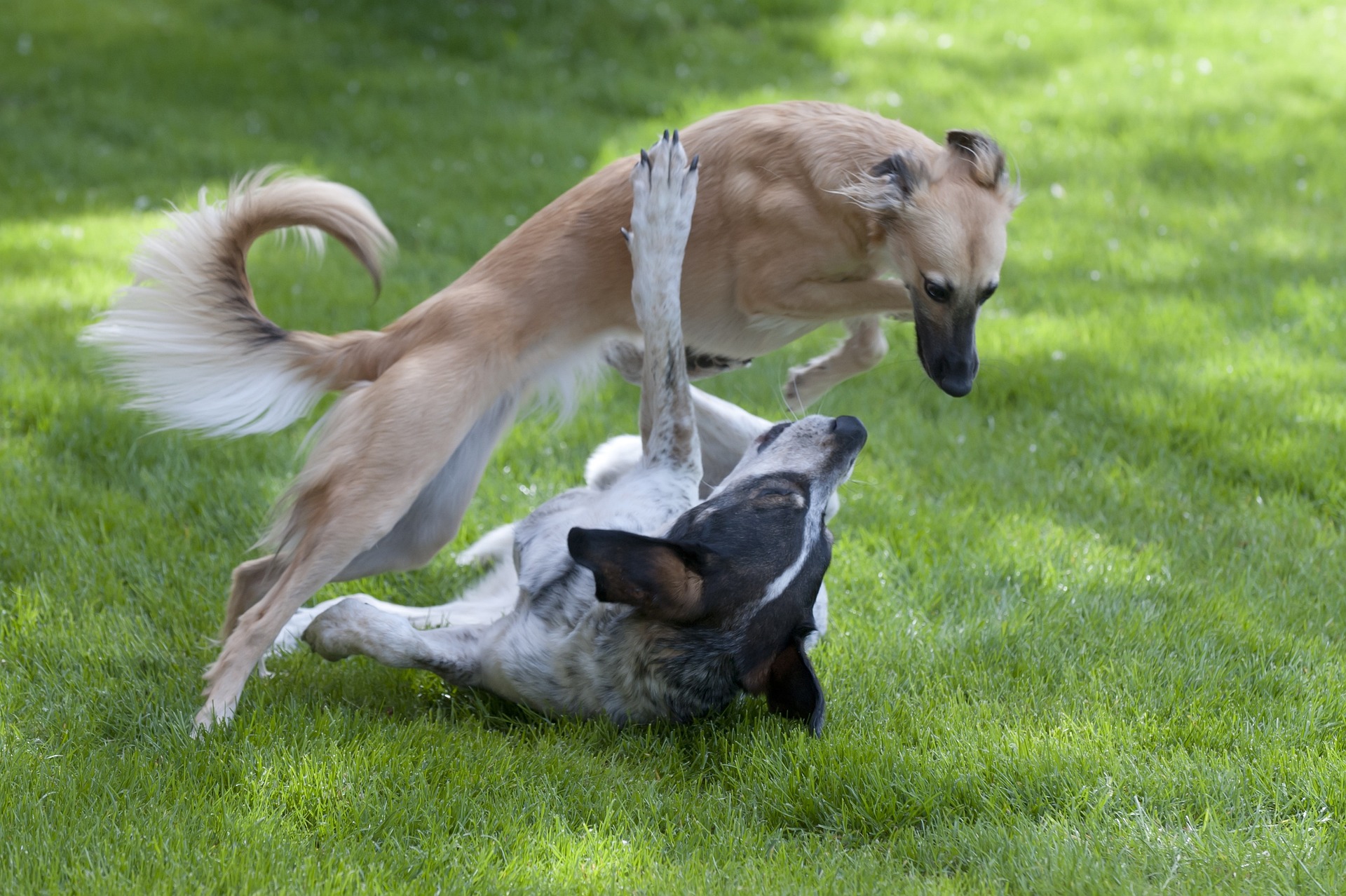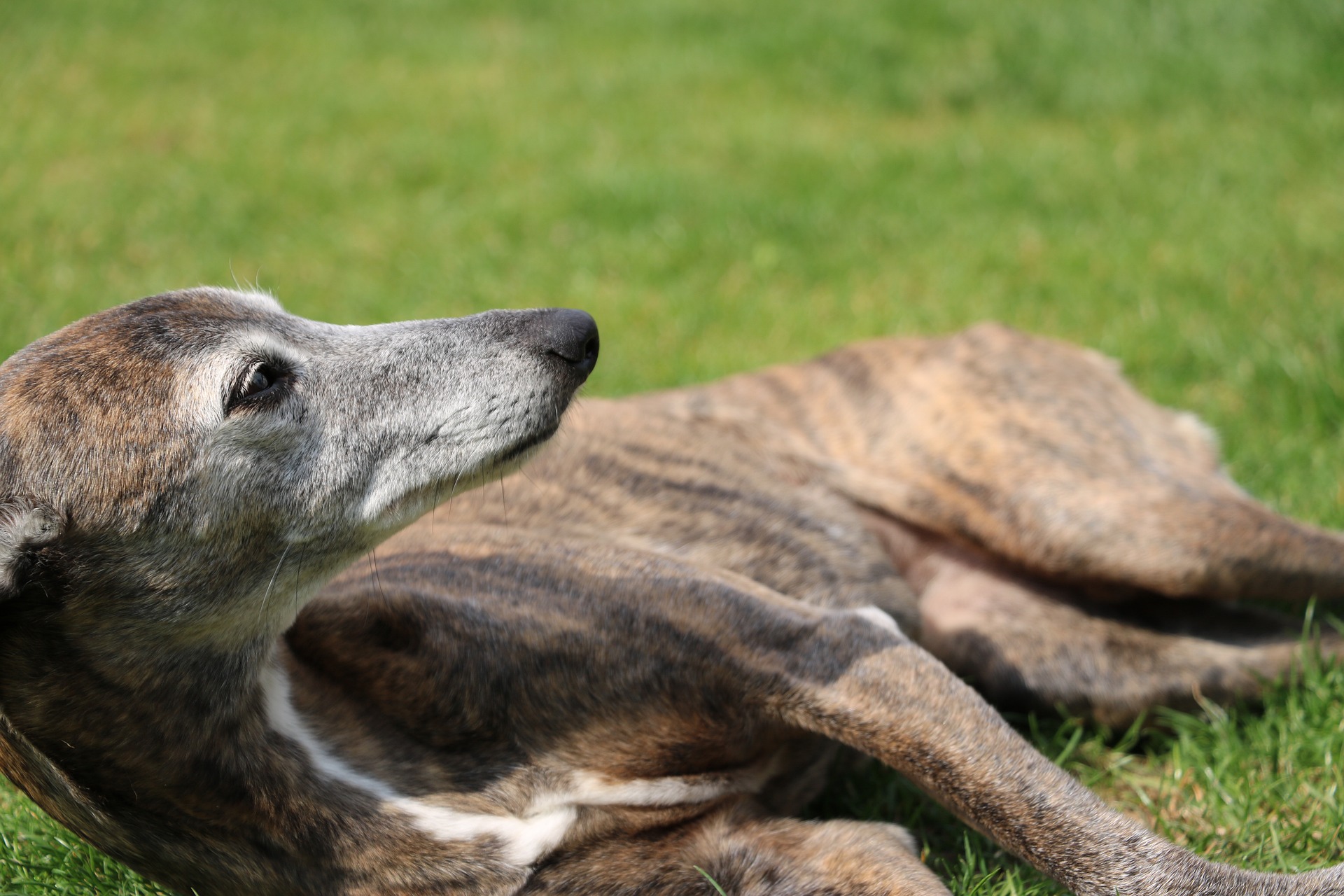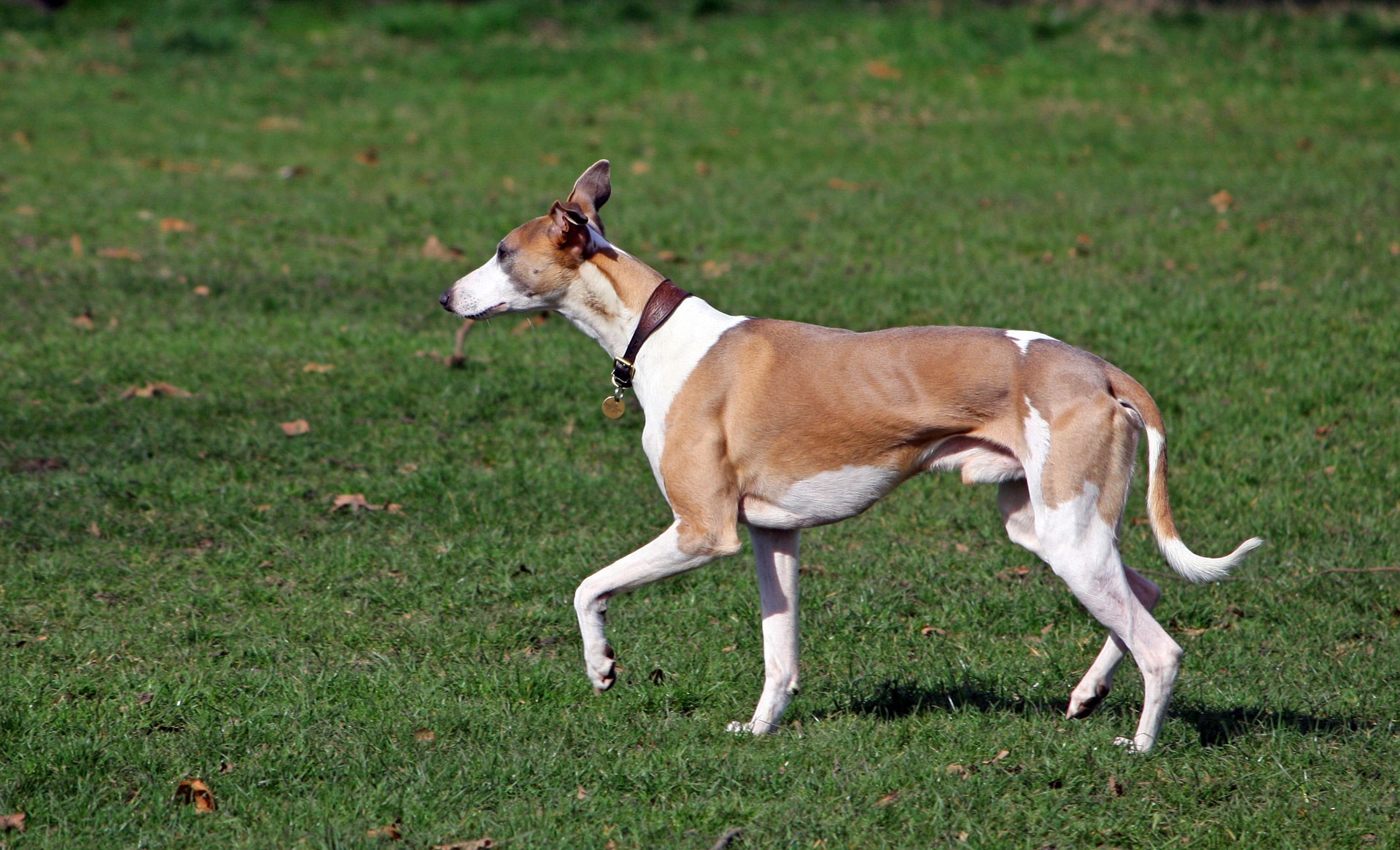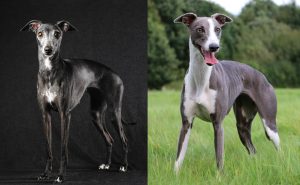The Whippet is a dog breed celebrated not only for its agility and speed but also for its vast palette of coat colors and markings that can make each dog distinct. Whippets may exhibit a single solid color or a mix, ranging from the soft tones of fawn and cream to the striking contrast of black and white. Often likened to small Greyhounds, Whippets carry their colors on a short and fine coat, which showcases their sleek physique and the distinct shape of any markings.
This breed’s coat colors are so varied that they span a rainbow spectrum, with the possibility of nearly any color or combination making an appearance. While some hues like fawn and brindle are common, others are more unusual and prized for their rarity. The American Kennel Club (AKC) states that color is immaterial to the breed standard, suggesting that a Whippet’s color does not affect its qualifications as a show dog. However, coat color can sometimes correlate with certain health conditions, making it an essential aspect to consider for both breeders and potential owners.
Today, we will look at all the Whippet colors combinations and patterns.
Key Takeaways
- Whippet coats come in a variety of colors and patterns, each contributing to the dog’s unique appearance
- Coat color is not a factor in show ring qualification per the AKC, highlighting the breed’s diverse color acceptance
- While selecting a Whippet based on color preference is common, it’s important to consider potential health implications linked to certain colors
Overview of Whippet Colors
Whippets come in a kaleidoscope of colors, ranging from single hues to a blend of shades influenced by complex genetics. They can sport solid colors or be attractively marked with a mixture of tones.
Genetics Behind Whippet Colors
The colors of a Whippet puppy’s coat are a product of its genetic makeup. Each pup inherits a combination of genes from its parents that determine the base color. Some genes are dominant, ensuring that a certain color is expressed, while others are recessive and might be hidden but can still be passed on to offspring. Additionally, there is a gene responsible for diluting the base color, transforming what could be a deep black into a soft grey. These genetic variables make each Whippet’s coat color unique.
Common Whippet Colors
Whippets exhibit an array of common colors. Base colors can be anything from black, blue, and fawn to cream, red, or white. Sometimes, you’ll encounter Whippets with solid colors, which means their coat is entirely one color with no other markings. More often, they’ll have a rich tapestry of colors in various patterns, which could include spots or stripes. They may also display darker or lighter brindle stripes, or even a distinct black mask. Here’s a snapshot:
- Solid Colors:
- Black
- Blue
- Fawn
- Cream
- Common Patterns:
- Brindle
- Spotted
- Masked
Understanding the genes behind these lovely colors and seeing the wide range can help anyone appreciate the diversity within the Whippet dog breed. Each coat tells a story of genetics at play, making every Whippet’s coloring as unique as their personality.
Specific Color Varieties
The purebred Whippet is a breed with a diverse palette of coat colors that range from standard hues to more unusual shades, all adding to its elegant appearance.
Standard Color Range
Whippets come in an array of standard colors that are widely recognized and admired. Here are a few:
- Fawn: A light yellowish-brown, resembling the soft colors of early fall
- Red: A rich, vibrant hue that can vary from a deep, rusty shade to a brighter red
- Tan: Often seen as a warm, golden color that brings a sunny disposition to the breed
- Cream: This subtle and soothing color can range from almost white to a light beige
Dilute and Rare Colors
Apart from the standard colors, Whippets may also exhibit dilute and rare colors, which can be quite captivating:
- Blue: A steel-gray to a soft slate color, seen in both solid and brindle patterns
- Gray/Silver: These colors have a metallic sheen and can vary from light to dark
- Blue Fawn: An exquisite combination of blue with fawn undertones
It’s not every day you’ll come across a Whippet with a blue merle coat or a silver brindle, but they do exist and are truly unique.
Markings and Patterns
The coats of Whippets can be decorated with various markings and patterns, much like artistic brush strokes on a canvas:
- Brindle: A striped pattern that can come in a range of colors such as fawn brindle, red brindle, blue brindle, and black
- Parti-color: This term describes Whippets with two or more colors, typically including white
- Black Mask/White Markings: Some Whippets have a dark mask over their face or charming white markings on their body
They also might sport patterns like brindle and white, blue and white, or black and white. Each Whippet’s markings are as individual as fingerprints – no two are exactly alike.
Breed Standards and Show Qualities
When considering the Whippet breed in terms of breed standards and show qualities, it’s essential to look at how kennel clubs define the ideal Whippet. These guidelines not only shape the expectations for show dogs but also influence breeder practices to maintain the breed’s distinctive traits. Nowadays, many people compare the Whippet dog breed to the Greyhound or Italian Greyhound. While they are similar in looks and purpose, they have their distinctive different colors.
American Kennel Club Standards
The American Kennel Club (AKC) sets specific guidelines that emphasize the Whippet’s inherent athletic elegance and functional attributes. According to the AKC, a Whippet should exhibit a medium size that portrays elegance, fitness, and an appearance denoting great speed, power, and balance. Their coat can display a variety of colors reflecting their gentle and dignified presence in the show ring. Breeders aiming to follow the AKC standards strive to cultivate these qualities to enhance the breed’s natural grace.
Key Attributes According to AKC:
- Medium size sighthound
- Appearance of elegance and fitness
- Denoting speed, power, and balance
UK Breed Standards
In the UK, breed standards for Whippets highlight not just physical attributes but also the breed’s temperament. They are known for their balanced combination of muscular power and strength paired with a graceful outline, fulfilling both the aesthetics expected in the show ring and the breed’s original purpose. Temperamentally, Whippets should show an even disposition, being both gentle and affectionate—traits that are cherished by breeders and pet owners alike.
Important UK Breed Standards:
- Balanced and muscular
- Graceful outline
- Gentle and affectionate temperament
Functional Attributes
Whippets are bred for both form and function. Their sleek form is more than just appealing to the eye—it serves a practical purpose. Originally bred for speed, they possess a streamlined body, enabling them to chase down game with fast, agile movements. Breeders, especially those aiming to maintain the essence of the Whippet beyond the show ring, pay close attention to these functional attributes. A Whippet should move with efficiency and grace, making every motion appear effortless.
Functional Attributes Sought by Breeders:
- Streamlined build for speed
- Agile and graceful movements
- Efficient gait
This breed’s endearing qualities of a gentle, affectionate nature combined with their athletic elegance resonates with Whippet breeders and enthusiasts worldwide. Whether through the AKC or UK standards, or in observers’ eyes, the Whippet stands out as a beacon of graceful athleticism and compassionate companionship.
Health and Grooming of Colored Whippets
Looking after a colored Whippet’s coat is not just about keeping them looking good; it’s about their overall health as well. Regular grooming keeps their coat sleek, while being mindful of certain color-related health conditions is crucial for their well-being.
Coat Care and Grooming
Grooming a Whippet puppy is relatively easy due to their short coat. Brushing once a week with a soft bristle brush or a hound glove should suffice to keep their coat nice and shiny. Their low-shedding coat makes them a good choice for those with allergies, though no dog can be truly hypoallergenic. When it comes to bathing, Whippets only need it occasionally, unless they’ve rolled in something smelly or gotten particularly dirty. It’s important to use a mild dog shampoo that maintains the natural oils in their skin and coat.
- Brushing frequency: Weekly
- Bathing frequency: As needed
Health Conditions Related to Coat Colors
Color in dogs is not merely cosmetic; it has a connection to genetics, and in some cases, genetics can play a role in their health. For instance, those with lighter coat colors, like blue or fawn, may sometimes be more prone to skin conditions due to a lack of protective pigmentation. It’s essential for a Whippet owner to keep an eye on their pet’s skin and coat for any signs of irritation or unusual hair loss, often much easier to spot on a short-coated breed. They should also regularly check with their vet, as certain pigmentation-related genes could be linked to specific health conditions.
- Watch for: Skin irritation, Unusual hair loss
- Vet check-ups: Regularly
Choosing a Whippet Color
When deciding on the color of a Whippet, prospective owners often consider how temperament, appearance, and predictability of coat colors through breeding lines play a role in their choice. The color of a Whippet can sometimes give a hint about its personality, and certain hues may even be tied to specific genetic traits.
Considering Temperament and Appearance
Whippets are known for their gentle and adaptable temperament, which makes them a cherished companion regardless of the coat color. While personality is an individual characteristic that varies from dog to dog, some owners believe certain colors can reflect a Whippet’s demeanor. Appearance-wise, Whippets come in a variety of colors and patterns that range from elegant solids to striking multi-color combinations. Owners looking for a beautiful canine companion might choose a color that they find aesthetically pleasing or that complements the dog’s quiet and intelligent nature.
While no scientific evidence suggests coat color directly impacts a Whippet’s behavior, colors like brindle can sometimes be associated with the breed’s racing heritage. Ultimately, it’s important for potential owners to remember that each Whippet’s individual personality is what makes them truly unique.
Breeding Line and Color Predictability
The predictability of a Whippet’s coat color relies heavily on its breeding line. When choosing a color, one should look into the breeding history to make an educated guess on future litters. Certain colors are linked to specific genes, and an understanding of genetics can help in predicting the appearance of puppies. For example, the dilute gene can alter standard colors to a soft, pastel-like hue.
Prospective Whippet owners considering breeding or showing should familiarize themselves with the breed standard colors and markings. Although most Whippets enjoy robust health, it’s good practice to be aware of any genetic conditions that can sometimes correlate with certain colors due to the complex nature of canine genetics.
When a family decides on adding a Whippet to their home, looking at the parents and asking breeders about color predictability can provide insight into the future coat of their pet. As with all aspects of choosing a pet, it is essential to prioritize the health and behavior of the animal over the aesthetics of their coat, ensuring a happy addition to the family.





